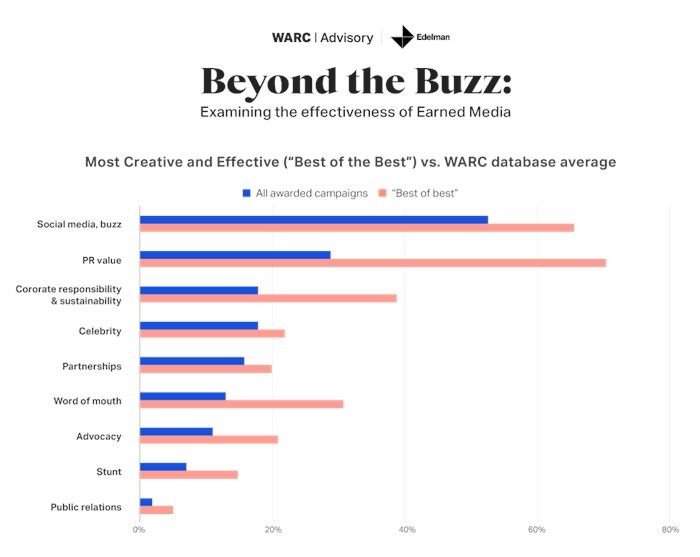A new white paper has been released by Warc Advisory and global communications firm Edelman.
Beyond the Buzz: Examining the Effectiveness of Earned Media explores how digital ubiquity and “advertising pollution” have set the scene for Earned Media to play a leading role in driving both creativity and effectiveness.
The digitally-driven cultural shift of the past two decades has fundamentally changed how Earned Media needs to be viewed as part of the marketing mix. Earned is a powerful vehicle for using creativity to connect brands to customers more impactfully, the report suggests. Marketers now need to rethink how they balance activity across Earned, Paid and Owned approaches.
The white paper’s most significant finding is that culturally salient creative work clearly outperforms non-culturally salient work in terms of profit, sales, and market share, highlighting how Earned Media’s unique ability to connect at scale with cultural relevance drives brand fame. Culturally salient campaigns also make budgets go further, the findings show. The “Halo Effect” demonstrates how uplift in sales of one product from a brand also boosted demand for other products in its portfolio - and culturally salient campaigns drove “halo effects” 11% points bigger than non-culturally salient campaigns.
Brent Nelsen, chief innovation and strategy officer, Edelman, says: “Earned Media uses cultural saliency to cut through the noise and drive business effects. Earned’s unique ability to take action in culture - participating in, creating, and changing culture - enables brands to drive greater levels of brand trust through actions that drive greater levels of growth.”
The white paper outlines how brands are now navigating through an era of digital coexistence. More traditional media outlets such as TV still have significant value, but social media has now overtaken paid search to become the world’s largest channel by ad spend, the white paper finds.
According to Warc Media analysis, global social media ad spend is forecast to total $247.3bn in 2024, up 14.3% year-on-year. While the average time spent on social platforms has increased to more than 2 ½ hours a day (up by 50%) since 2014, and worldwide user numbers across social platforms have risen 169% in the same period.
Data analysis from Warc’s global rankings, outlined in the report, demonstrate that the “best of the best” of the world’s top marketing campaigns based on performance in the world’s most prestigious awards for creativity and effectiveness, over-index in their application of Earned Media approaches. PR value was a soft metric measured by 71% of the most awarded ideas for creativity and effectiveness compared to 29% for all awarded campaigns. That over-indexing is mirrored in other tactics commonly associated with Earned Campaigns, including Word-Of-Mouth and Advocacy.

In an era where all the spaces in which we spend so much time, and consume so much content are proliferated with low quality advertising, the analysis suggests, it has contributed to the era of communications “pollution”, making it harder than ever for messages to achieve the attention needed for brands to grow. A majority of Americans, 63% of UK GenZ, and one third of the global population now use ad blockers. This finding occurs across multiple channels, including Podcasts and Streaming, as well as Live TV.
Key takeaways outlined in Beyond the Buzz: Examining the Effectiveness of Earned Media are:
Shifting hierarchies across Paid, Owned and Earned
Given the digitally driven cultural transformation of the past two decades, marketers need to rethink how they balance activity across Earned, Paid and Owned approaches.
Maximise effectiveness with The 5 Rs of Earned
Exploiting the opportunity for “Earned Effectiveness” in an infinitely connected world involves leveraging the diversity of spaces where customers experience their lives. “The 5 Rs of Earned”—Reach, Relevance, Reputation, Response, and Revenue—outline key objectives in Earned campaigns, enabling brands to generate mass visibility and build higher levels of brand trust.
Connect culture with creativity for best-in-class results
While the definitions of media, message, culture and commerce are more blurred than ever, there are exceptional examples of earned creativity-driven effectiveness. The white paper presents best-practice use of Earned in driving effectiveness in a number of case studies within this report.
Beware the “Earned Fallacy”
In a world where marketers need to leave no stone unturned in the hunt for effectiveness, there is headroom to exploit using Earned Media campaigns. There is strong evidence for how Earned Media contributes critical brand building and commercial metrics.
However, despite the data explored in the whitepaper - which establishes how Earned Media contributes towards exceptional creative and effective results - most brands are using it with lesser effects. The report defines this gap as the “Earned Fallacy”, showing examples of Earned led campaigns there are at the top of Warc’s Creative Effectiveness Ladder, compared to the prevalence of Earned Media approaches used at the lower levels despite evidence of the effectiveness of Earned in the media mix.
Aditya Kishore, insight director, Warc, added: “Earned media offers marketers a way of engaging with their audiences and finding creative ways to stand out in today’s very noisy media landscape. Its ability to participate in cultural trends, and to potentially lead rather than only follow, allows brands unique opportunities to develop connections with their audience.
“This report spells out the media landscape marketers face, and the clear benefits that a well-thought out earned media strategy can offer brands, providing insight for marketers on the benefits of an effective earned media approach.”
A full copy of the white paper is available to download for a limited time here.






































































